Lansdowne station (MBTA)
Lansdowne station (formerly Yawkey station) is an MBTA Commuter Rail station in Boston, Massachusetts. It serves the Framingham/Worcester Line. It is located next to the Massachusetts Turnpike in the Fenway–Kenmore neighborhood near Kenmore Square, below grade between Beacon Street and Brookline Avenue.
Lansdowne | |||||||||||
|---|---|---|---|---|---|---|---|---|---|---|---|
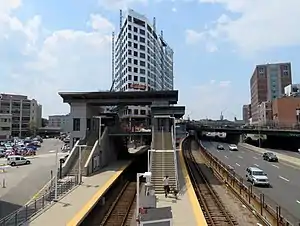 Fenway Center construction over Lansdowne station in July 2019 | |||||||||||
| Location | 85 Brookline Avenue, Boston, Massachusetts | ||||||||||
| Coordinates | 42°20′51″N 71°06′02″W | ||||||||||
| Line(s) | Worcester Main Line | ||||||||||
| Platforms | 2 side platforms | ||||||||||
| Tracks | 2 | ||||||||||
| Connections | At Kenmore: | ||||||||||
| Construction | |||||||||||
| Disabled access | Yes | ||||||||||
| Other information | |||||||||||
| Fare zone | 1A | ||||||||||
| History | |||||||||||
| Opened | April 29, 1988[1] | ||||||||||
| Rebuilt | March 10, 2014[2] | ||||||||||
| Previous names | Yawkey | ||||||||||
| Passengers | |||||||||||
| 2018 | 1,195 (weekday average boardings)[3] | ||||||||||
| Services | |||||||||||
| |||||||||||
The station, originally named after former Boston Red Sox owner Tom Yawkey, opened as an infill station in 1988, for limited service to baseball games at Fenway Park. Regular commuter service began in 2001 for riders headed to Boston University, Kenmore Square, and the Longwood Medical and Academic Area. Inbound and outbound trains formerly shared a single two-car platform on the inbound track, requiring passengers to embark or debark from the front two cars of outbound trains or the rear two cars of inbound trains.
In 2012, work began on a new, fully accessible station, including two longer high-level platforms and an overhead pedestrian bridge which will eventually allow direct access from the Beacon Street and Brookline Avenue overpasses through the planned Fenway Center development. Passengers boarded from the east end of the new station from June 2013 until March 10, 2014; after delays, it opened fully that day. The new station is served by all Worcester Line trains, which was expected to increase ridership from 585 total daily boardings and alightings to 937. By a 2018 count, there were 2,491 daily (1,195 boardings and 1,296 alightings).[3]
The station was renamed Lansdowne (after nearby Lansdowne Street) effective April 8, 2019, following the May 2018 renaming of Yawkey Way back to Jersey Street.
History
Former stations
The Boston and Worcester Railroad (B&W) opened to West Newton on April 16, 1834, and was extended westwards soon after.[4] An early station was located at the west end of the Boston & Roxbury Mill Dam, near what is now Kenmore Square. It was variously known as Beacon Street, Mill Dam, Brookline, and Brookline Junction — the latter name reflecting the Brookline Branch (later the Highland Branch), which opened in 1848.[4][5][6][7]:154 By 1857, passenger service there was replaced with Cottage Farm station (later University station), a flag stop at Commonwealth Avenue in the Cottage Farm neighborhood.[5][8] The Boston and Albany Railroad (successor to the B&W) maintained a freight yard at Brookline Junction into the 20th century.[9][10]
Service on the Highland Branch ran until May 31, 1958, when it was abandoned for conversion to the Riverside Line; a stub remained at Brookline Junction until the 1970s for freight service.[4][5] The B&A attempted to drop all service to University, Brighton, and Faneuil in February 1958; however, minimal service was maintained until the railroad discontinued all commuter stops east of Newtonville in April 1959.[11][12][13] Remaining commuter service on the line was subsidized by the Massachusetts Bay Transportation Authority (MBTA) beginning in 1973, eventually coming under full public control as the Framingham Line.[1]:340[4]
Game-day service
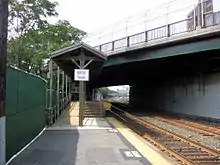
Originally named in honor of long-time Boston Red Sox owner Tom Yawkey, the station was opened on April 29, 1988, and initially was only used for special service to Fenway Park for baseball games.[1] It was used by Framingham Line trains as well as special weekend-only "Fenway Flyer" baseball trains from the Attleboro (now Providence/Stoughton), Fairmount, and Franklin lines. Service from the Attleboro and Fairmount lines began on July 12, 1988, followed by the Franklin Line on July 27.[14] The "Fenway Flyer" trains had an annual ridership of 58,000 in 1990.[15] The station became popular enough that the MBTA added regular commuter service. This largely obviated the need for "Fenway Flyer" specials, though certain weekend Providence trains ran to Yawkey as late as 2007.[16] Similar special trains continue to serve Foxboro station during football and soccer games and special events at Gillette Stadium.[17]
The station was built with a low-level asphalt platform and was not initially accessible.[18] With the pending passage of the Americans with Disabilities Act of 1990 (ADA), the MBTA began a project to build a mini-high platform on March 14, 1990.[14] However, the mini-high platform only served one of the line's two tracks, limiting the number of trains that could stop at the station.
Regular service
In early 2000, the MBTA released a study which analyzed the possibility of full-time commuter service to then-Yawkey station to serve workers at nearby Boston University, Kenmore Square, and the Longwood Medical and Academic Area. An addendum released in August 2000 analyzed increased service (on all modes) to Fenway Park on game days. Possibilities studied included running game day service from the Plymouth/Kingston Line with an unused trainset, a South Station-Yawkey shuttle, increased Green Line service, and bus shuttles to the Red Line in Cambridge and to Ruggles station. Consideration was given to building a dedicated terminal spur and station on the remains of the former Highland Branch.[19]
Regular weekday commuter service to the station began on January 2, 2001, with four daily round trips. Weekend service was still initially limited to game days.[1][20] Regular weekend service was added on April 30, 2001.[1] From 2001 to 2014, not all trains stopped at the station; most peak-direction trains stopped, but many off-peak trains did not. Before the rebuilding began in 2012, some trains stopped at the station only on game days during the Red Sox season.[21]
New station
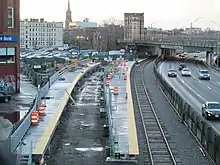
In August 2007, the MBTA published a feasibility study exploring the possibility of rebuilding the station as a full-service station.[22] The study concluded that doing so would increase ridership by 60%, from 585 daily boardings and alightings to 937.[23] On November 15, 2010, Governor Deval Patrick and other officials broke ground on a major rebuilding of the station, originally expected to be completed in the spring of 2012.[24] The new station has two full-length high-level platforms that provide level, handicapped-accessible boarding for all passengers; the old platform had only a wooden ramp for accessibility. The two 700-foot-long platforms (a side platform between the tracks plus a side platform on the south side of the tracks) are connected with an overpass, and passengers no longer have to cross the tracks to access certain outbound trains.[25][26]
The rebuilt station was intended to be the first component of a larger, mostly private development called Fenway Center. The new station, which cost about $13.5 million, was planned to be powered entirely by solar panels after the development opened.[24] Although the developer, Meredith Management Corporation, wished to close the station during rebuilding, the MBTA elected to keep it open.[27][28] Fenway Center, which was to be built on the air rights over the adjacent Massachusetts Turnpike (I-90), would eventually cover much of the station.[25] As part of the development, walkways would be built above the station, allowing passengers to walk directly to the pedestrian bridge and platforms from Beacon Street and Brookline Avenue rather than passing through private parking lots. After lengthy negotiations, an air-rights deal between the city and the developer regarding Fenway Center was reached in May 2013.[29] In July 2017, the developer and the state reached an agreement under which the buildings south of the station would be built first. The developer would pay the state $21 million for the right to delay building the deck, but will owe $3 million more if construction does not begin by the end of 2020.[30]
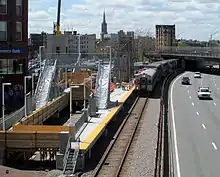
The Framingham/Worcester line schedule was changed slightly in April 2012 to allow for temporary single-tracking through the station for construction.[31] Actual station construction activity started in June 2012, and in August one track was cut, reducing the line to one track through the station. The platforms were installed in late November 2012; construction of the elevator shafts began in February 2013. A temporary ramp opened in June 2013 for passengers to use the east end of the future outbound platform; the old platform was demolished soon afterwards to make room for the west ends of the new platforms. The pedestrian bridge was lifted into place in August 2013, followed by the various roof and canopy elements. The second track was rebuilt in late September, followed by the remaining platform segments.
The new station fully opened on March 10, 2014, coinciding with planned service increases on the Framingham/Worcester Line. Before the reconstruction, 17 trains stopped at the station each weekday; after, all 48 daily trains (24 round trips) stopped.[2][24] The opening was first planned for January 13, then January 27, but was delayed due to problems with the station's elevators and adjustments to the schedule based on public comment.[32][33][34] The walkway between the new station and Fenway Park includes large lit statues of the uniform numbers retired by the Red Sox.[35]
After special events, such as concerts at Fenway Park, the MBTA sometimes runs special commuter rail shuttles from the station to South Station.[36]
Cancelled plans
The station was a proposed stop on the Urban Ring Project.[37] The Urban Ring was to be a circumferential bus rapid transit (BRT) line designed to connect the current radial MBTA rail lines, to reduce overcrowding in the downtown stations, but it was canceled in January 2010.[38] Under draft plans released in 2008, the Urban Ring would access then-Yawkey station via Mountfort Street to the north and a new tunnel paralleling the Green Line D branch to the southwest, with a turnoff and station at Overland Street.[39]
In 2014, it was revealed by the state that the stop would be part of the proposed Indigo Line system with frequent DMU service, but that plan was canceled in 2015.[40][41]
Renaming
In December 2015, The Boston Globe columnist Adrian Walker proposed renaming Yawkey Way and Yawkey station after alleging their namesake, Tom Yawkey, was a racist who made the Red Sox the last major league team to hire black players.[42] In August 2017, amid heightened media coverage of the removal of Confederate monuments and memorials in the United States, the Red Sox organization began advocating for the city to change the street's name. A bill to change the station's name was filed in the state legislature.[43] Changing the street name was approved in April 2018 and implemented in May 2018.[44] The MBTA announced that the station would also be renamed, though a new name was not immediately determined.[45] On March 28, 2019, the MBTA announced that the station would be renamed Lansdowne (after nearby Lansdowne Street) effective April 8.[46]
Station design
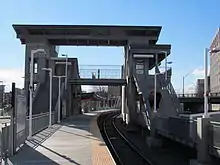
| Overpass | Overpass between platforms | |
| Ground/ Platforms |
Outbound | ← Framingham/Worcester Line toward Worcester |
| Side platform, doors will open on the left | ||
| Inbound | Framingham/Worcester Line toward South Station → | |
| Side platform, doors will open on the right | ||
The station is fully accessible, with two full-length high-level platforms and elevators to cross from one track to another. The overhead pedestrian bridge is designed to connect to a future deck between Brookline Avenue and Beacon Street as part of the Fenway Center project.[25][26] The main entrance to the station is on Overland Street between the two major streets; staircases to Beacon Street are also available from the west ends of the platforms. The Beacon Street staircases were closed on December 1, 2018, due to the construction of Fenway Center.[47] They are expected to reopen in March 2020.[48]
The station has an unusual platform layout, where the outbound side platform is between the tracks rather than to the side. This is because the station is located on a tight curve; doors located on the end of passenger cars would have gaps next to a convex platform.[49][50]
Connections
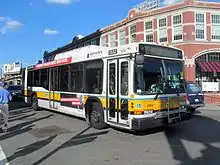
Four MBTA bus routes stop on Brookline Avenue at Jersey Street:[51]
- 8: Harbor Point–Kenmore station
- 19: Fields Corner station–Kenmore or Ruggles station
- 60: Chestnut Hill–Kenmore station
- 65: Brighton–Kenmore station
Kenmore station, located 0.25 miles (0.40 km) to the northeast along Brookline Avenue, provides connections to the B, C, and D branches of the MBTA Green Line, as well as bus routes 57 and 57A.
MASCO, a consortium of medical facilities and universities, runs a number of private and semi-private bus routes that serve its member organizations. Its "Fenway" shuttle route stops at Lansdowne station as well as Fenway Park parking lots.[52]
References
- Belcher, Jonathan. "Changes to Transit Service in the MBTA district" (PDF). NETransit. pp. 345, 349. Page numbers are accurate to the April 21, 2018 version.
- Rocheleau, Matt (February 26, 2014). "MBTA to open rebuilt Yawkey Station in March, boosting service on Framingham-Worcester rail line". Boston Globe. Archived from the original on March 4, 2016. Retrieved March 6, 2014.
- Central Transportation Planning Staff (2019). "2018 Commuter Rail Counts". Massachusetts Bay Transportation Authority.
- Humphrey, Thomas J.; Clark, Norton D. (1985). Boston's Commuter Rail: The First 150 Years. Boston Street Railway Association. pp. 21–25. ISBN 9780685412947.
- Karr, Ronald Dale (2017). The Rail Lines of Southern New England (2 ed.). Branch Line Press. pp. 338–346. ISBN 9780942147124.
- "Our New England Letter". The Station Agent. Vol. 1 no. 6. August 1889. p. 188 – via Google Books.
- Kennedy, Charles J. (Summer 1962). "Commuter Services in the Boston Area, 1835-1860". The Business History Review. 36 (2): 153–170. doi:10.2307/3111453. JSTOR 3111453.
- Barrett, Richard C. (1996). Boston's Depots and Terminals. Railroad Research Publications. p. 207. ISBN 1884650031.
- Atlas of the City of Boston. G.W. Bromley & Co. 1915. Plate 11 – via Ward Maps.
- Post Office Department Annual Reports for the year ended June 30, 1913. United States Post Office Department. 1914. p. 211 – via Google Books.
- "DPU Permits B.&M. 5% Intrastate Fare Boost". Daily Boston Globe. April 15, 1959. p. 11 – via Newspapers.com.

- "B. & A. Drops Two Trains, Some Stops". Boston Globe. February 5, 1958. p. 6 – via Newspapers.com.

- "Protests Save One Stop a Day At University". Boston Globe. February 22, 1958. p. 14 – via Newspapers.com.

- Sanborn, George M. (1992). A Chronicle of the Boston Transit System. Massachusetts Bay Transportation Authority. Archived from the original on April 16, 2019 – via Massachusetts Institute of Technology.
- Middleton, William D. (November 1, 1991). "How MBTA rebuilt ridership". Railway Age. p. 33. Archived from the original on June 11, 2014 – via Highbeam Research.
- "Providence/Stoughton Line Schedule" (PDF). Massachusetts Bay Transportation Authority. April 30, 2007. Archived from the original (PDF) on January 5, 2010.
- "Gillette Stadium". Massachusetts Bay Transportation Authority. Retrieved June 12, 2018.
- Operations Directorate Planning Division (November 1990). "Ridership and Service Statistics" (3 ed.). Massachusetts Bay Transportation Authority. pp. 1–5 – via Internet Archive.
- KKO and Associates (August 2000). Fenway Park Game Day Service Improvement Study. Feasibility of Full-Time Commuter Rail Service to the Fenway/Kenmore Area. Massachusetts Bay Transportation Authority.
- "New Buses, Weekly Passes Highlight Recent MBTA Improvements" (PDF). TRANSreport. Boston Metropolitan Regional Planning Organization. February 2001. Archived from the original (PDF) on December 9, 2010.
- "Massachusetts Bay Transportation Authority Commuter Rail Executive Summary" (PDF). Massachusetts Bay Transportation Authority. 2010.
- Edwards & Kelcey, Inc.; et al. (August 2007). MBTA Yawkey Station Feasibility Study. Massachusetts Bay Transportation Authority. OCLC 192139849.
- Tetra Tech (August 10, 2012). "Boston University Charles River Campus Transportation Master Plan" (PDF). Boston University. p. 51.
- "PATRICK-MURRAY ADMINISTRATION, CITY OF BOSTON BREAK GROUND ON YAWKEY STATION PROJECT" (Press release). Massachusetts Bay Transportation Authority. November 15, 2010.
- Richards Barry Joyce and Partners. "Fenway Center" (PDF). Meredith Corporation. Archived from the original (PDF) on March 11, 2014.
- Rocheleau, Matt (July 24, 2013). "MBTA: $14.9m redesign of Yawkey commuter rail station to be finished this fall". Boston Globe. Archived from the original on March 5, 2016. Retrieved July 24, 2013.
- Grillo, Thomas (July 2, 2010). "Developer tells T: Fast-track Yawkey plan". Boston Herald. Retrieved July 19, 2011.
- "Yawkey Station Construction". MASCO. Archived from the original on March 11, 2014. Retrieved March 18, 2012.
- Ross, Casey (May 13, 2013). "Patrick administration, developer John Rosenthal strike air rights deal for Fenway Center over Mass. Pike". Boston Globe. Archived from the original on March 4, 2016. Retrieved September 11, 2013.
- Vaccaro, Adam; Logan, Tim (July 17, 2017). "Long-delayed Fenway Center project moves ahead". Boston Globe. Retrieved July 22, 2017.
- "Reconstruction of Yawkey Station Results In Schedule Adjustments For Worcester Line" (Press release). Massachusetts Bay Transportation Authority. March 23, 2012.
- "Worcester Line Train Times Effective January 13, 2014" (PDF). Massachusetts Bay Transportation Authority. January 13, 2014. Archived from the original (PDF) on January 8, 2014.
- Bard, Megan (January 14, 2014). "MBTA expands Worcester – Boston commuter rail service starting Jan. 27". MassLive. Retrieved August 10, 2015.
- Kush, Bronislaus B. (January 8, 2014). "MBTA adding trains on Worcester commuter line". Worcester Telegram. Retrieved January 8, 2014.
- Silva, Steve (April 2, 2014). "Refurbished third base deck, new menu offerings highlight Fenway Park changes for 2014 season". Boston Globe. Retrieved June 12, 2018.
- Massachusetts Bay Transportation Authority (August 4, 2015). "Commuter Rail Service Alerts: Framingham/Worcester Line". Archived from the original on August 6, 2015.
- "Urban Ring Phase 2 FACT SHEET" (PDF). January 2009. Archived from the original (PDF) on July 8, 2011.
- Mullan, Jeffery B. (January 22, 2010). "Re: Urban Ring Phase 2, EOEEA #12565" (PDF). Massachusetts Executive Office of Energy and Environmental Affairs.
- "The Urban Ring Phase 2: Revised Draft Environmental Impact Report/Statement" (PDF). Massachusetts Executive Office of Transportation. November 2008. Archived from the original (PDF) on February 27, 2017.
- Annear, Steve (January 9, 2014). "Take A Ride On The MBTA's 'New Indigo Line' In 2024". Boston Magazine. Retrieved June 12, 2018.
- Stout, Matt (June 20, 2015). "Charlie Baker derails T trains". Boston Herald. Archived from the original on July 27, 2015.
- Walker, Adrian (December 7, 2015). "It's time to banish the racist legacy of Tom Yawkey". The Boston Globe. Retrieved December 8, 2015.
- Silverman, Michael (August 18, 2017). "'Haunted' by past owner's history, Red Sox seek name change for Yawkey Way". Boston Herald. Retrieved August 19, 2017.
- "So long Yawkey Way! Boston officially changes name of street outside Fenway Park". WCVB-TV. May 3, 2018.
- Vaccaro, Adam (April 26, 2018). "So, what to call Yawkey MBTA station?". Boston Globe.
- "MBTA Announces Yawkey Station on Framingham/Worcester Line Will Be Renamed Lansdowne" (Press release). Massachusetts Bay Transportation Authority. March 28, 2019.
- "Service Alerts and Notices". Massachusetts Bay Transportation Authority. November 27, 2018. Archived from the original on December 2, 2018.
On 12/1, the Beacon Street entrance to Yawkey Station will close for approximately one year due to the Fenway Center construction project. Access will be via Maitland Street and David Ortiz Way.
- "Alerts: Commuter Rail". Massachusetts Bay Transportation Authority. January 9, 2020. Archived from the original on February 6, 2020.
- "Commuter Rail Book of Standard Plans: Track and Roadway" (PDF). Massachusetts Bay Transportation Authority. October 28, 1992. p. 1019. Archived from the original (PDF) on March 4, 2016.
- Devadoss, Rajkumar; Ahmad, Shan Sanjar; Raman, Dhamodharan (2012). "Platform–train interface for rail passengers – a technology review" (PDF). CRC for Rail Innovation. p. 6.
- "Yawkey Neighborhood Map" (PDF). Massachusetts Bay Transportation Authority. August 2013. Archived from the original (PDF) on March 4, 2016.
- "Routes". Medical Academic and Scientific Community Organization. Retrieved March 31, 2020.
External links
| Wikimedia Commons has media related to Lansdowne station. |
- MBTA – Lansdowne (official site)
- Google Maps Street View: from I-90, David Ortiz Drive, Beacon Street
- Fenway Center Development
